

Keith Reeves sur Twitter : "I appreciate the @VSTE Board articulating today that the extant #Virginia statute (SOQ 2.J.) mandating 1 school technical support staff : every 1000 students is essential, but also nigh insufficient in the context of meaningful.
Senate Dems want answers on rescinded affirmative action guidance. INTERIM StandardsFINAL 07222. K–12-Computer-Science-Framework. 3 Ways to Deploy 3000 Devices in Your District. Free Online Assessment Evaluates a School's Technology Needs. Smart Classroom Free Online Assessment Evaluates a School's Technology Needs An educational technology consulting firm has created a 20-question online assessment tool it says will help schools and school districts determine if they are prepared to support the technology needs of K-12 students.

Take the ETSA test... - vidalcasey.com. NETP16. Revisions to No Child Left Behind Attempt to Define Education Technology. Weighing in at an overbearing 1,059 pages on November 30, 2015, the proposed revisions to No Child Left Behind (NCLB)—collectively dubbed the Every Student Succeeds Act (ESSA)—are a tough bull to ride.
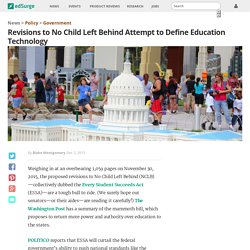
(We surely hope our senators—or their aides—are reading it carefully!) The Washington Post has a summary of the mammoth bill, which proposes to return more power and authority over education to the states. POLITICO reports that ESSA will curtail the federal government’s ability to push national standards like the Common Core and limit the power of the Secretary of Education. Framework for 21st Century Learning. P21's Framework for 21st Century Learning was developed with input from teachers, education experts, and business leaders to define and illustrate the skills and knowledge students need to succeed in work, life and citizenship, as well as the support systems necessary for 21st century learning outcomes.

It has been used by thousands of educators and hundreds of schools in the U.S. and abroad to put 21st century skills at the center of learning. The P21 Framework represents both 21st century student outcomes (as represented by the arches of the rainbow) and support systems (as represented by the pools at the bottom). National Education Technology Plan. Contribute to the 2021 NETP Development If you would like to contribute to the development of the 2021 NETP, please share your thoughts here:Share your Input 2021 National Education Technology Plan.
21 education technology recommendations for 2016. And in order to illustrate some of the plan’s main ideas and recommendations, it includes examples of how technology, when used appropriately, can transform education.
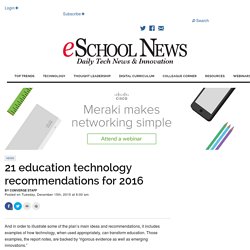
Those examples, the report notes, are backed by “rigorous evidence as well as emerging innovations.” Here’s what the Education Department recommends, in our own words: 1. Create an anywhere, anytime learning environment that’s equally accessible to all students. 2. Incorporate learning science design principles into ed tech resources. 3. Work backwards so that learning technology resources and methods lead to the desired student learning outcomes. 4.
eSchool News 10 changes a school library must consider in the digital era. Interactive Achievement onTRAC Login. eSchool News Education gets spotlight in SOTU. President Obama devoted part of the annual State of the Union address to improving education and access Mykhaylo Palinchak, 2014/Shutterstock.com President Obama in his Jan. 20, 2015 State of the Union Address highlighted the need for high-speed broadband for all Americans, access to higher education opportunities, and the need to protect student data in information.
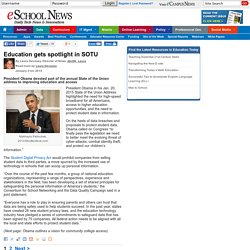
On the heels of data breaches and proposals to protect student data, Obama called on Congress “to finally pass the legislation we need to better meet the evolving threat of cyber-attacks, combat identity theft, and protect our children’s information.” The Student Digital Privacy Act would prohibit companies from selling student data to third parties, a move spurred by the increased use of technology in schools that can scoop up personal information. “Everyone has a role to play in ensuring parents and others can trust that data are being safely used to help students succeed. eSchool News Five tech-savvy schools that focus on ed-tech. These five schools and districts are modeling ed-tech success.
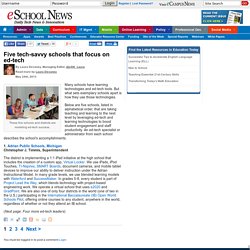
Many schools have learning technologies and ed-tech tools. But what sets exemplary schools apart is how they use those technologies. Below are five schools, listed in alphabetical order, that are taking teaching and learning to the next level by leveraging ed-tech and learning technologies to boost student engagement and staff productivity. 5 ed tech predictions for 2015. Ed tech policymakers and experts weigh in on the year ahead Last year, in addition to the tremendous attention on Common Core’s ups and downs, educators also found time to weigh the merits of greater access to broadband in (and out of) the classroom, as well as gaming and learning, the use of Google tools, and the power of data to make decisions.
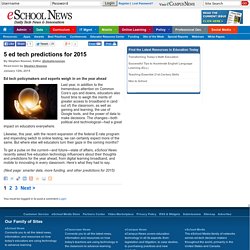
The changes—both political and technological—had a great impact on educators everywhere. Likewise, this year, with the recent expansion of the federal E-rate program and impending switch to online testing, we can certainly expect more of the same. But where else will educators turn their gaze in the coming months? Valuable advice from tech coordinators. Tech leaders and coordinators propose effective approaches to managing technology and projects School and district technology directors have important responsibilities and face new challenges each day.
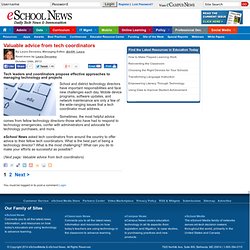
Mobile device programs, software updates, and network maintenance are only a few of the wide-ranging issues that a tech coordinator must address. Sometimes, the most helpful advice comes from fellow technology directors–those who have had to respond to technology emergencies, confer with administrators and advocate for technology purchases, and more. A World of Knowledge: 50 Different Views of Education. Education sprouts in many forms depending on how you look at it.

Our views of what it should look like and how it should materialize depend on our value of it and our experience with it. What if a class consisted of words that led to information that whirled into blended realms of creativity set up just for students, created by students. The students then dictated what they learned instead of reluctantly ingesting information and standards imposed upon them. That exists here and now. In every nook and cranny, around every corner, inside every well-engineered lesson, students might just learn what they want to learn and actually find success while improving the world around them.
Take a tour of 50 different views of education that somehow find a similar note: Education must change. 1. Sir Ken Robinson campaigns changing education through talks, writing, advising, and teaching. 2. 3. 4. According to John Taylor Gatto, teachers should choose the real world over the classroom. 5. Dr. 6. 7. 8. Libraries Play A Central Role in Connected Learning. The Internet offers today’s youth unprecedented opportunities to connect with peers and seek knowledge in almost any area of interest—and libraries are uniquely positioned to play a central role in this learning, according to Mimi Ito, professor and cultural anthropologist at the University of California, Irvine, and principal investigator for Connected Learning, a new education model funded by the MacArthur Foundation’s Digital Media and Learning Initiative.
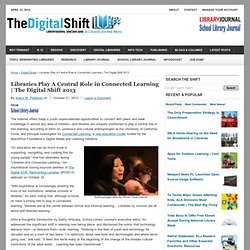
Anthropologist Mimi Ito. Photo: Paolo Sacchi. January 2014 eSchool News. Change and challenge: tips on moving forward in the face of resistance. I received the following email recently about the difficulty of dealing with resistant or challenging people in workshops: I serve schools as a math and data coach throughout the State. I am writing you looking for some ideas. I generally work with low-achieving schools and often a staple of the school culture in these schools is that the adults have a victim-like mentality. I hear some of the same negative statements over and over again that are personally frustrating and disappointing for me to hear as a person and a fellow educator.
I am writing you looking some guidance on how you would respond to some or all of the following statements that I’m sure you have heard before, some examples: “The teachers here are great, we just need better students”“The state uses voodoo math to determine which schools are struggling, our school is fine; it’s the state that needs to make changes” Here was my response, expanded for this post: Yes, such fatalistic attitudes are all too common. 1. 2. 3. 4. Getting Started - Schools and Libraries Program - USAC.org. Full access to telecommunications and information resources makes possible the rich teaching and learning that take place in schools and libraries.
For these institutions to provide the high level of service necessary for their students and patrons to participate fully in American society, the costs can be great. Telecommunications and Internet access, the hardware needed for assembling local networks, and maintenance of systems and machines can stretch budgets that are already under stress. The universal service Schools and Libraries Program, commonly known as the E-rate Program, helps ensure that schools and libraries can obtain telecommunications and Internet access at affordable rates.
Want to get started? The first step is to learn about eligibility. If you’re an applicant, once you understand eligibility, your next step is to review the application process. 5 trends poised to rock education. Trend #1: Big data “Now that we no longer have the anemic kind of media that we used to have to store data—and this is a relatively new development—we can store all the data we want,” Ohler said. “And if we can store all the information we want, we’re going to store all the information we can.” In fact, the extent to which we have created ways to gather, store, and analyze information is “mindboggling,” Ohler said. Consider a petabyte of data, which is 1015 bytes of data. Teaching Keyboarding: More Than Just Typing. While schools have worked hard to integrate computers into the classroom and many do a great job teaching students how they work, many schools do not even consider teaching the art/science of using a keyboard.
"Many teachers think it takes nothing to teach keyboarding, but they are wrong," said teacher Carla Cruzan. "Can anyone teach a science or math course? " Technology Improves And The Internet Expands But School Acceptable Use Policies Still Lock Students Out Of The Benefits. Trying to change teacher practice? Enlist 'Bob' U.S. Department of Education issues guidelines on student data privacy. K12Spotlight_July07.pdf (application/pdf Object) eSchool News Are these 8 trends the future of K-12? Will Education Technology Push Students in 2014?
Envisioning-the-future-of-education.png (PNG Image, 1600 × 2263 pixels) “NOTHING MORE IMPORTANT THAN THIS”: Obama Visits Brooklyn High School to Push for Education Priorities, Including High School Redesign, High-Speed Internet in Schools, and Increased Funding. A Map of Education Technology Through 2040 [#Infographic] 6 Technology Challenges Facing Education. A state-by-state look at top ed-tech initiatives.
E-Rate.